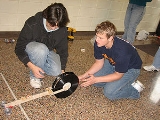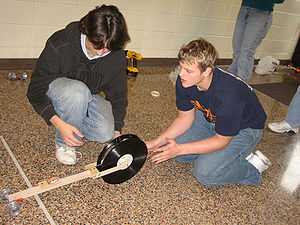
Mousetrap car
Encyclopedia

Vehicle
A vehicle is a device that is designed or used to transport people or cargo. Most often vehicles are manufactured, such as bicycles, cars, motorcycles, trains, ships, boats, and aircraft....
having only one form of motive power being from a mousetrap
Mousetrap
A mousetrap is a specialized type of animal trap designed primarily to catch mice; however, it may also trap other small animals. Mousetraps are usually set in an indoor location where there is a suspected infestation of rodents. There are various types of mousetrap, each with its own advantages...
. Variations include the use of multiple traps, or very big rat traps, for added power.
Mousetrap cars are very often used in physics or other physical science
Physical science
Physical science is an encompassing term for the branches of natural science and science that study non-living systems, in contrast to the life sciences...
classes to help students build problem-solving skills, develop spatial awareness, learn to budget time, and practice cooperative behavior.
Design
The general style for a mousetrap car varies.Most people choose four-wheeled cars, but three-wheeled and two-wheeled cars also exist. One way to increase distance is to replace the string that pulls the axle with a rubber band. Larger wheels will increase the distance obtained using the same amount of energy. Using more string than what is needed will cause the string to rewind around the axle after the string runs out.
Spring Power
A mousetrap is powered by a helical torsion springTorsion spring
A torsion spring is a spring that works by torsion or twisting; that is, a flexible elastic object that stores mechanical energy when it is twisted. The amount of force it exerts is proportional to the amount it is twisted. There are two types...
. Torsion springs obey an angular form of Hooke's law
Hooke's law
In mechanics, and physics, Hooke's law of elasticity is an approximation that states that the extension of a spring is in direct proportion with the load applied to it. Many materials obey this law as long as the load does not exceed the material's elastic limit. Materials for which Hooke's law...
:

where
 is the torque
is the torqueTorque
Torque, moment or moment of force , is the tendency of a force to rotate an object about an axis, fulcrum, or pivot. Just as a force is a push or a pull, a torque can be thought of as a twist....
exerted by the spring in newton-meters, and
 is the angle of twist from its equilibrium position in radian
is the angle of twist from its equilibrium position in radianRadian
Radian is the ratio between the length of an arc and its radius. The radian is the standard unit of angular measure, used in many areas of mathematics. The unit was formerly a SI supplementary unit, but this category was abolished in 1995 and the radian is now considered a SI derived unit...
s.
 is a constant with units of newton-meters / radian, variously called the spring's torsion coefficient, torsion elastic modulus, or just spring constant, equal to the torque required to twist the spring through an angle of 1 radian. It is analogous to the spring constant of a linear spring.
is a constant with units of newton-meters / radian, variously called the spring's torsion coefficient, torsion elastic modulus, or just spring constant, equal to the torque required to twist the spring through an angle of 1 radian. It is analogous to the spring constant of a linear spring.The energy of U, in joule
Joule
The joule ; symbol J) is a derived unit of energy or work in the International System of Units. It is equal to the energy expended in applying a force of one newton through a distance of one metre , or in passing an electric current of one ampere through a resistance of one ohm for one second...
s, stored in a torsion spring is:

When a mousetrap is assembled, the spring is initially twisted beyond its equilibrium position so that it applies significant torque to the bar when the trap is closed.
Power Transmission to Axle
The mousetrap bar travels through an arc of approximately 180 degrees. This motion must be used to turn the car's axle or wheels. The most common solution is to attach a string to the bar and wrap it around an axle. As the bar is released, it pulls on the string, causing the axle (and wheels) to turn.Tying the string directly to the mousetrap's bar, however, will not make good use of the energy stored in the spring. The distance between the opened and closed positions of the bar of a mousetrap is typically 10 cm, so this is how much string would be pulled. Wrapped around even a small diameter axle, this amount of string will not create enough revolutions to move the car as far as it might go.
To get around this problem, most mousetrap cars add a lever to the bar so that the lever will pull a much greater length of string and cause the axle to turn many more revolutions.
Friction of Wheels
Another reason to add a lever to the mousetrap bar is to reduce the amount of torque applied to the wheels. If too much torque is applied to the wheels, the force between the wheels and the ground will exceed the maximum frictional force due to the coefficient of friction between the wheel and ground surfaces. When this happens, the wheels slip and energy stored in the spring is wasted. Using a long lever on the mousetrap bar reduces the tension in the string due to the spring's torque, and thus reduces the torque applied to the car's wheels.In addition to reducing the torque applied to the wheels, the coefficient of friction may be improved by using higher friction materials.
Variations on Mousetrap Cars
A number of commercial vendors offer plans, kits and complete cars for sale.In addition to mousetrap cars, contests have been created for mousetrap boats and mousetrap airplanes.
External links
- Mousetrap Car Demonstration of a mousetrap powered car

